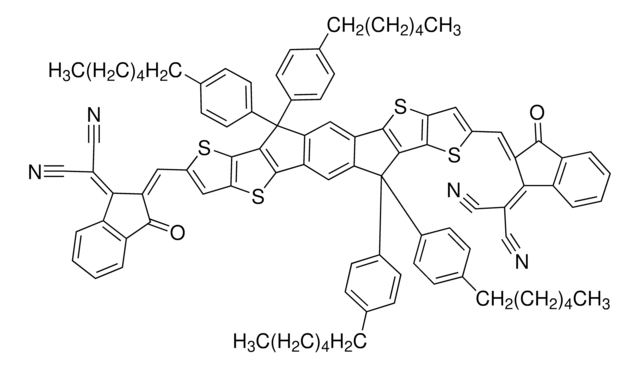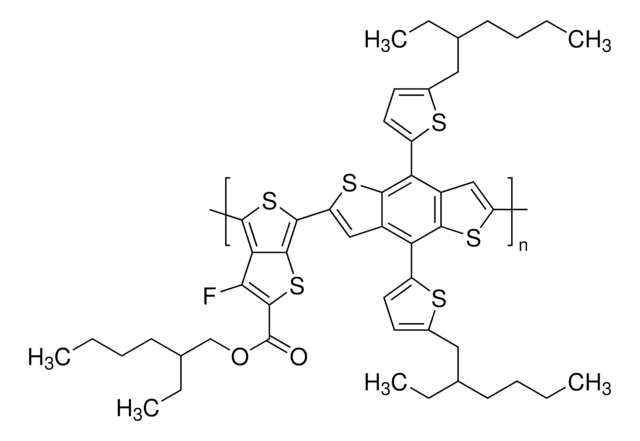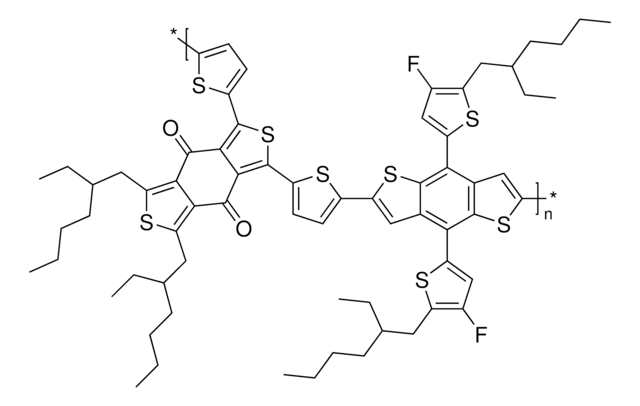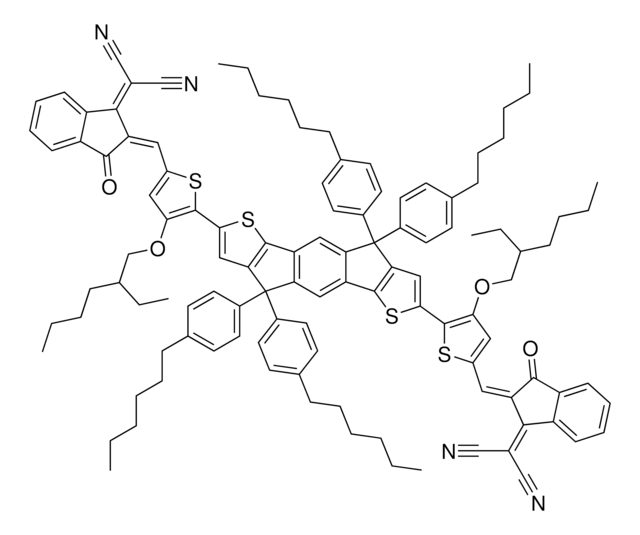910635
IDT-2Br
≥99%
Sinónimos:
5,5′-[[4,4,9,9-Tetrakis(4-hexylphenyl)-4,9-dihydro-s-indaceno[1,2-b:5,6-b′]dithiophene-2,7-diyl]bis(2,1,3-benzothiadiazole-7,4-diylmethylidyne)]bis[3-ethyl-2-thioxo-4-thiazolidinone], IDT-BT-R
About This Item
Productos recomendados
description
Band gap: 1.83 eV
assay
≥99%
form
solid
mol wt
1518.20 g/mol
color
dark
solubility
chloroform: soluble
orbital energy
HOMO -5.52 eV
LUMO -3.69 eV
General description
Application
Ternary blend organic solar cells (OSCs) with photoresponses beyond 1000 nm can be fabricated using PTB7-Th as donor and ultralow-bandgap F8IC and medium-high bandgap IDT-2BR as NFAs. A PCE of 12.1% has been achieved by such a ternary device with 20% IDT-2BR content in acceptors. In this work, IDT-2BR was found to contribute simultanously to the improvement of the open-circuit voltage (VOC), short-circuit (JSC) and fill factor (FF) of the PTB7-Th/F8IC blend, due to smaller energy offset for charge separation, suppressed charge recombination, and imporved light absorption. Improved packing due to the coexsitence of F8IC and IDT-2BR leads to higher mobilities and more balanced charge transport, which contribute to the improved FF as well.
Additionaly, blends with IDT-2BR have been found to be thermally stable at 150 Celsius.
A ternary blend using both IDT-2BR and fullerene based acceptor: PC71BM (Product No. 684465) has also reached a PCE over 12%.
Storage Class
13 - Non Combustible Solids
wgk_germany
WGK 3
flash_point_f
Not applicable
flash_point_c
Not applicable
Elija entre una de las versiones más recientes:
Certificados de análisis (COA)
Lo sentimos, en este momento no disponemos de COAs para este producto en línea.
Si necesita más asistencia, póngase en contacto con Atención al cliente
¿Ya tiene este producto?
Encuentre la documentación para los productos que ha comprado recientemente en la Biblioteca de documentos.
Artículos
The emerging organic photovoltaic (OPV) technology is very promising for low-cost solar energy production. OPV devices can be produced using high-throughput, large-volume printing methods on lightweight and flexible plastic substrates, making them easy to deploy and use in innovative ways.
The emerging organic photovoltaic (OPV) technology is very promising for low-cost solar energy production.
Professor Chen (Nankai University, China) and his team explain the strategies behind their recent record-breaking organic solar cells, reaching a power conversion efficiency of 17.3%.
Nuestro equipo de científicos tiene experiencia en todas las áreas de investigación: Ciencias de la vida, Ciencia de los materiales, Síntesis química, Cromatografía, Analítica y muchas otras.
Póngase en contacto con el Servicio técnico


![Poly[(9,9-dioctylfluorenyl-2,7-diyl)-co-bithiophene] 99.9%](/deepweb/assets/sigmaaldrich/product/structures/309/000/8b4a3f54-7765-4aca-96c4-74ce328d455d/640/8b4a3f54-7765-4aca-96c4-74ce328d455d.png)




